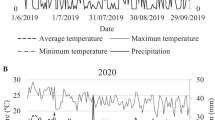Abstract
Nineteen accessions of the tuber-bearing species Solanum berthaultii, S. chacoense, S. leptophyes, S. microdontum, S. sparsipilum, S. sucrense, S. venturii, S. vernei and S. verrucosum were tested for their resistance to late blight in two years of field experiments. Plants were artifically inoculated with zoospores of race 1.2.3.4.5.7.10.11 and the development of the disease was followed. Resistance ratings, calculated as the areas under the disease progress curves (ADPC), demonstrated a high resistance in all accessions except in S. sparsipilum, S. leptophyes and their interspecific hybrid. Segregations suggest that major genes for resistance are present in S. sucrense and S. venturii, and may also play a role in S. verrucosum. It is not yet certain wether the resistance of the other accessions is comparable to the partial and durable resistance of S. tuberosum cultivars like Pimpernel, as inheritance and mechanism have yet to be established. However, segregations suggesting the presence of single major genes with complete dominance were not found in these other accessions. Tuber initiation in the field occurred in only one accession, S. tuberosum ssp. andigena, and maturity of the clones was not related to their resistance. In the other accessions maturity types could not be assessed, as the clones require short day conditions for tuber initiation.
Similar content being viewed by others
Abbreviations
- ADPC:
-
area under the disease progress curve
- BGRC:
-
Braunschweig Genetic Resource Center
References
Black, W., 1954. Late blight resistance work in Scotland. Am Potato J 31: 93–100.
Black, W. & M.E. Gallegly, 1957. Screening of Solanum species for resistance to Phytophthora infestans. Am Potato J 34: 273–281.
Eide, C.J., R. Bonde, M.E. Gallegly, K. Graham, W.R. Mills, J. Niederhauser & J.R. Wallin, 1959. Report of the Late Blight Investigations Committee. Am Potato J 36: 421–423.
Fry, W.E., 1978. Quantification of general resistance of potato cultivars and fungicide effects for integrated control of potato late blight. Phytopathology 68: 1650–1655.
Graham, K.M., 1962. Inheritance of partial resistance to Phytophthora infestans in Solanum verrucosum Schlecht. Am Potato J 39: 391 (abstr.).
Hanneman, R.E. & J.B. Bamberg, 1986. Inventory of tuberbearing Solanum species. Wisc Agric Exp St Bull 533, 216 pp.
Hawkes, J.G., 1958. Potato. I. Taxonomy, cytology and crossability. In: Kappert, H. & W. Rudorf, (Eds.), Handbuch der Pflanzenzüchtung. Band III. Züchtung der Knollen und Wurzelfrucharten, pp 1–43. Paul Parey Verlag, Berlin/Hamburg.
Hockstra, R. & L. Seidewitz, 1987. Evaluation data on tuberbearing Solanum species (second edition). German-Dutch curatorium for plant genetic resources, Braunschweig, Federal Republic of Germany.
Hohl, H.R. & K. Iselin, 1984. Strains of Phytophthora infestans from Switzerland with A2 mating type behaviour. Trans Br Mycol Soc 83: 529–530.
Kogut, I. & N.D. Koval, 1987. Producing potato forms with resistance to late blight by using diploid species. Sel Semenovod, USSR 1: 24–25.
Lipski, A., E. Sawicka & J. Pietkiewicz, 1978. Resistance to Phytophthora infestans (Mont.) de Bary occurring in some Solanum species. Biul Inst Ziemniaka 22: 17–23.
Malcolmson, J.F. 1969. Races of Phytophthora infestans occurring in Great Britain. Trans Br Mycol Soc 53: 417–423.
Malcolmson, J.F., 1985. Phytophthora infestans A2 compatibility type recorded in Great Britain. Trans Br Mycol Soc 85: 531.
Malcolmson, J.F. & W. Black, 1966. New R genes in Solanum demissum Lindl. and their complementary races of Phytophthora infestans (Mont.) de Bary. Euphytica 15: 199–203.
Nilsson, B.A. 1981. Component analysis of general resistance to Phytophthora infestans in clones from the Colombian potato collection. Potato Res 24: 239–244.
Ross, R.W. & P.R. Rowe, 1969. Inventory of tuber-bearing Solanum species. Wisc Agric Exp St Bull 533, 68 pp.
Sanford, L.L. & T.L. Ladd, 1987. Recurrent selection for potato leafhopper resistance in potato, Solanum buberosum L. Gp. tuberosum. Am Potato J 64: 367–375.
Schick, R., E. Schick & M. Haussdörfer, 1958. Ein Beitrag zur physiologischen Spezialisierung von Phytophthora infestans. Phytopathol Z 31: 225–236.
Shaner, G. & R.E. Finney, 1977. The effect of nitrogen fertilization on the expression of slow-mildewing resistance in Knox wheat. Phytopathology 67: 1051–1056.
Shaw, D.S., A.M. Fyfe, P.G. Hibberd & M.A. Abdel-Sattar, 1985. Occurrence of the rare A2 mating type of Phytophthora infestans on imported Egyptian potatoes and the production of sexual progeny with A1 mating types from the UK. Plant Pathol 34: 552–556.
Simmonds, N.W. & J.F. Malcolmson, 1967. Resistance to late blight in andigena potatoes. Eur Potato J 10: 161–166.
Snedecor, G.W. & W.G. Cochran, 1980. Statistical Methods (7th ed.). The Iowa State University Press, Ames, Iowa, USA.
Soest, L.J.M. van & W Hondelmann, 1983. Taxonomische und Resistenz-untersuchungen an Kartoffel-wildarten und-primitivformen der Deutsch-Niederländischen Sammelreise in Bolivien 1980. Landbauforsch Voelkenrode 33: 11–23.
Soest, L.J.M. van, B. Schöber & M.F. Tazelaar, 1984. Resistance to Phytophthora infestans in tuber-bearing species of Solanum and its geographical distribution. Potato Res 27: 393–411.
Tazelaar, M.R., 1981. The screening of Solanum species for horizontal resistance to late blight (Phytophthora infestans) and its use for breeding programmes. 8th Triennial Conference of the EAPR (München). Abstracts of Conference Papers: 34–36.
Toxopeus, H.J., 1958. Some notes on the relations between field resistance to Phytophthora infestans in leaves and tubers and ripening time in Solanum tuberosum subsp. tuberosum. Euphytica 7: 123–130.
Toxopeus, H.J., 1964. Treasure digging for blight resistance in potatoes. Euphytica 13: 206–222.
Umaerus, V., M. Umaerus, L. Erjefält & B.A. Nilsson, 1983. Control of Phytophthora by host resistance: problems and progress. In: Erwin, D.C., S. Bartnicki-Garcia, & P.H. Tsao, (Eds.) Phytophthora, its biology, taxonomy, ecology and pathology. The American Phytopathological Society, St Paul, Minnesota, USA, pp 315–326.
Author information
Authors and Affiliations
Rights and permissions
About this article
Cite this article
Colon, L.T., Budding, D.J. Resistance to late blight (Phytophthora infestans) in ten wild Solanum species. Euphytica 39 (Suppl 3), 77–86 (1988). https://doi.org/10.1007/BF00043370
Received:
Accepted:
Issue Date:
DOI: https://doi.org/10.1007/BF00043370




